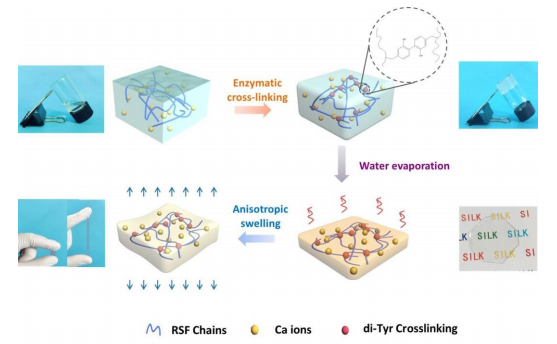Highly stretchable and anti-freezing silk-based conductive hydrogel for applications as a self-adhesive and transparent ionotronic skin
Bohua Zhao, Qianying Chen, Gaohuan Da, Zhengzhong Shao, Jinrong Yao and Xin Chen
https://doi.org/10.1039/D1TC01587G

Abstract
Soft electronic devices have rapidly developed and gained increasing attention in the past few years. Herein, a conductive silk-based hydrogel is prepared by crosslinking regenerated silk fibroin (RSF) aqueous solution with horseradish peroxidase (HRP) and adding a large amount of CaCl2 to hold water. The obtained RSF/CaCl2/HRP hydrogel is highly stretchable (breaking strain of 600% with an elastic modulus of 20 kPa) and transparent because the introduction of Ca(II) ions suppresses the formation of silk fibroin β-sheet crystals in the hydrogel. In addition, the presence of CaCl2 endows the RSF/CaCl2/HRP hydrogel with anti-drying and anti-freezing properties. The hydrogel remains soft (breaking strain of approximately 580%) and conductive (conductivity of 0.17 S/m) at -30°C. Moreover, the RSF/CaCl2/HRP hydrogel possesses good self-adhesive properties on different substrates, including wood, glass, metal, and plastic. Peeling strength of the hydrogel from hog skin is better than that of the commercial bandage tape. More importantly, the RSF/CaCl2/HRP hydrogel possesses both strain and temperature sensing ability. Hence, it can be assembled into a strain/temperature dual sensor. Such a highly stretchable, transparent, and self-adhesive strain/temperature dual sensor is a good candidate for an ionotronic skin. When tested as an ionotronic skin, the results show that this RSF-based hydrogel monitors body movements very well and can even recognize voice information from throat movements. Therefore, the proposed novel silk-based conductive hydrogel has promising potential in applications of soft electronic devices.